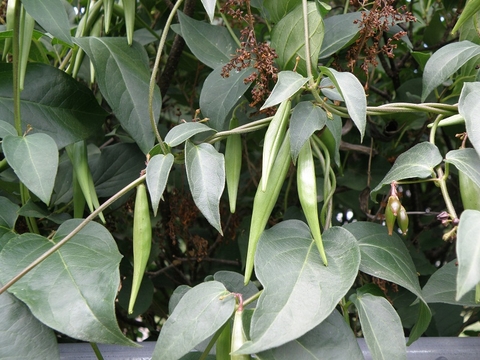How to Get Rid of Black Swallow Wort
- Home
- News
- Report and remove black swallow-wort plant to help monarch butterflies
Autumn is a good time to search
University of Minnesota Extension is bringing awareness to black swallow-wort, Cynanchum louiseae, an invasive plant originally brought to the U.S. from Europe as an ornamental vine. The plant presents a problem for monarch butterflies, which already face challenges to their survival, and it threatens natural areas.
Because of its large seedpods forming now, autumn is a good time to look for the plant and destroy it before pods break open and disperse seeds.
Angela Gupta, Extension educator in forestry and natural resources, has been including the plant in her workshops and public outreach for about six years. "It's in the milkweed family, so monarchs will lay their eggs on it," she says. "However, when the larvae emerge they can't survive on black swallow-wort and so they die."
Black swallow-wort is on the Minnesota Department of Agriculture (MDA) noxious weed eradicate list and is considered toxic to the monarch caterpillars.

Master Gardener turns find into opportunity to educate
As an Extension-trained Master Gardener volunteer of nine years in Hennepin County, as well as a Bachman's store manager, Janelle Dahmen knows her plants. It still took her by surprise to find black swallow-wort on her own property. "I saw this vine I'd never seen it before, and it was all over the neighborhood," she says. "If you know nothing about it, it's a beautiful plant with shiny leaves and it grows in sun or shade. One person had it on a trellis."
Dahmen took a photo and reported her discovery to the MDA. Monika Chandler, invasive plant expert, paid her a visit.
"Janelle reported black swallow-wort in the Longfellow neighborhood of Minneapolis," says Chandler. "With her network, Master Gardeners got the word out. This led to a new detection in North Oakdale in Washington County. This was a new county find (the species had not been confirmed previously in the county)."
Master Gardeners have since been sharing information through garden tours, farmers markets and community councils, and with their neighbors. Dahmen has also helped spread the word through the information desk at Bachman's.
"It is terrific that Master Gardeners are identifying, reporting and educating people about black swallow-wort," says Chandler.
"We are all interested in monarchs," says Dahmen. "We plant flowers for pollinators, but we want to make sure people know that, even though monarchs may seem to like this one, it isn't one to keep."
Removing and reducing black swallow-wort
"We think we have very little of it in the state, so eradication is possible if it's found and reported quickly," says Gupta, who often collaborates with Chandler about invasive plants to align agency and educational efforts.
The most effective treatment is spot-treating with a selective herbicide, making sure to always follow herbicide label directions. There is a risk that herbicide treatment could harm other plants nearby. If you opt not to use herbicide, you can hand pull the vines. Unfortunately, the vines break off from the roots when pulled. Digging out the complete roots is ideal but difficult because they break as well.
Repeated vine pulling multiple times during the summer and fall may eventually exhaust the vines. Additionally:
- It is important to make sure no pods release seed or the problem will be compounded.
- Now (September) is the time to chemically treat or pull the vines.
- In Minneapolis, put pulled vines in your yard waste that is hauled for composting. The yard waste will be composted at high heat levels that will kill the vines and any seed. Inquire locally for disposal options in other cities and counties.
- Do not put vines in your personal compost bin.
Visit the Extension invasive plants, MDA pest management and MDA Arrest the Pest websites for more information and to learn how to report invasive plants and other pests.
------
Media Contacts: Allison Sandve, University of Minnesota Extension, ajsandve@umn.edu, 612-626-4077 (office) or 651-492-0811 (mobile); Allen Sommerfeld, Allen.Sommerfeld@state.mn.us 651-201-6185
How to Get Rid of Black Swallow Wort
Source: https://extension.umn.edu/news/report-and-remove-black-swallow-wort-plant-help-monarch-butterflies#:~:text=Removing%20and%20reducing%20black%20swallow%2Dwort&text=The%20most%20effective%20treatment%20is,can%20hand%20pull%20the%20vines.